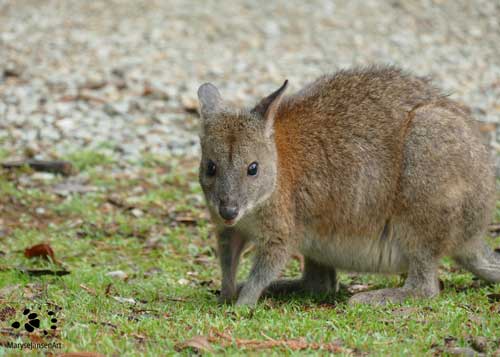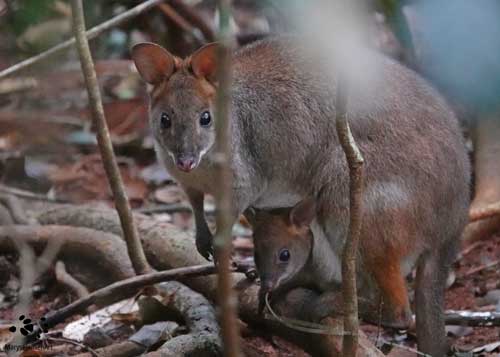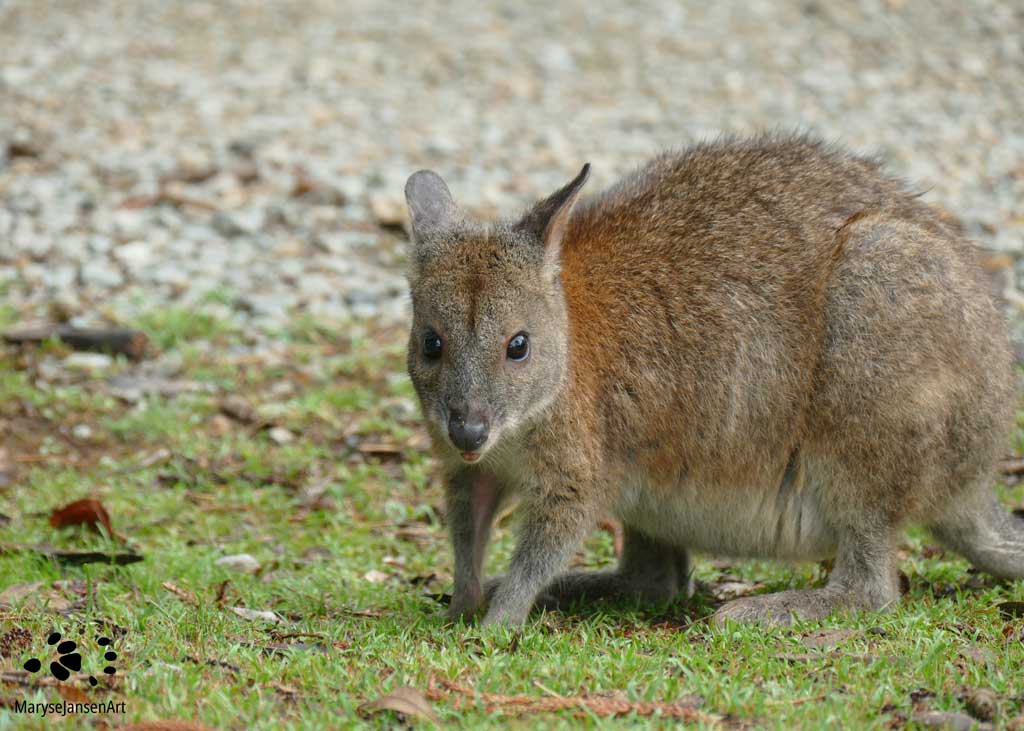Wildlife Photography with marysejansenart
A life in the darkness of the rainforest

Table of Contents
Spotting and photographing a Pademelon
I crawl out of my tent. It’s very early in the morning and everybody else appears to be still asleep, but I need to go to the toilet. When I open the zipper I am confronted with a thick fog. A dozen meters away I notice a small figure on the grass, it appears to be grazing. Very quietly I sneak up a little bit closer, until I can see the animal properly. It’s a Pademelon!
The toilet will have to wait! As quietly as I can I zip the tent back open and grab my camera. The fog is clearing and I’m not letting the opportunity pass to get a good photo of this super shy animal! I am camping in the rainforest which is the realm of the Pademelons. Only at dawn and dusk will they venture out to graze on the grassy areas that fringe the forest, such as this campsite. During the rest of the day they hide out in the dark corners of the rainforest.
I have spotted Pademelons in other rainforests before. But indeed it was so dark in there that the camera could barely pick them up as they were moving around in the undergrowth at a respectable distance from me. Of course I would never use a flash, which would be disturbing them, possibly be bad for their eyes and … it wouldn’t give a good result anyway over that distance!
You always have to respect the animals, so sometimes you need to accept that it is not a good moment for photos, and just enjoy the moment! Actually, where I said ‘sometimes’, I could probably replace that with ‘often’. Although, to be honest, often I can’t help myself and take photos anyway even if I know they are not going to be very good. They still make good memories and are also great for the purpose of identifying the species! Either way, you can see this is an exciting opportunity! And how cute does this animal look!
Red-necked Pademelons
Pademelons are marsupials and belong to the family of Macropods, just like the Kangaroos. They look a bit like a mini Wallaby. There are 3 species of Pademelon in Australia: The Rufous-bellied Pademelon – also known as the Tasmanian Pademelon, the Red-legged Pademelon and the Red-necked Pademelon.
The one I am looking at is the Red-necked Pademelon, you can see it in the featured image. Red-necked Pademelons have a brown-grey fur with a distinct red tint on the neck and shoulders, which may extend all the way to the forehead. Their belly is cream coloured. They have a short tail, up to 50cm. They are only up to 60cm tall. The males are considerably bigger then the females, almost twice their size! Red-necked Pademelons live in wet forests in the coastal region of eastern Australia ranging from south-east Queensland to central eastern New South Wales.
Feeding behaviour
These shy animals prefer to hide in the forest and when they are lying in the leaf litter you may have a really hard time spotting them. The colour of their fur will have them perfectly camouflaged! When it’s cold however, they might venture out to find a sunny spot to bask.
At dawn and dusk they like to come out of the cover of the forest to enjoy grazing on a grassy area. While they are mostly solitary, they may be spotted out grazing like this in small groups. They make thumping noises with their hind feet to communicate danger, upon which the whole group is quick to disappear into the forest again. They use established pathways in and out of the forest to travel to and from their grazing grounds.
Apart from grass they also eat roots, leaves and bark for which they forage in the forest.
Breeding behaviour
Breeding season for the Pademelons is in autumn and spring in the north and in the south it’s during the summer. Not much is known about mating. Males may make soft clucking calls to attract a female to mate with. They can mate with multiple females.
After 30 days, the female gives birth to a single joey. Just like with kangaroos, the joey is very small, naked, blind and helpless. Somehow this little creature finds its own way into the pouch and latches on to the teat. It stays there for about 6 months. Leaving the pouch is a gradual process, which takes many months. During that time, the joey is still intensively cared for until it is mature enough to fend for itself. Pademelons reach sexual maturity at 18 months of age and they have a lifespan of about 9 years.

Red-legged Pademelons
Today I am doing a rainforest walk and I intend to film the 50th episode of ‘Come for a walk in the Australian Bush’. A special occasion, so I decided to come to this place that I know from past visits to be a beautiful forest. I feel sure that there will be something special to see here today. As soon as I walk from the car to the entry of the walk I spot a Red-necked Pademelon on the grass. Wow! It’s early, but not that early, so I didn’t expect that! I catch it on video while it’s taking its last few bites before it hops away, into the safety of the rainforest.
I begin to walk, and pretty soon I spot another Pademelon, foraging in the darkness of the undergrowth. It peers at me through the bushes from a distance. And not much later, there’s another one! I can’t believe my luck! And when I look closer, through my zoom lens, I can see that these two are Red-legged Pademelons!! How exciting!
These are very similar to the Red-necked Pademelons in size, but I can clearly see the difference in colouring, where the red is on the legs instead of on the neck and shoulders! Also they have a distinct white cheek stripe and a more faint hip stripe. Red-legged Pademelons prefer the rainforest as their home but may also be seen in wet sclerophyll forests.
They range from the top of Cape York in Queensland to Tamworth in New South Wales so they are more widespread then the Red-necked species. This does not mean they are more often seen, they also are known to be very shy creatures. Pretty much all the other information that I just wrote about the Red-necked Pademelons also applies to the Red-legged Pademelons.
I have actually not seen Pademelons in this forest before, but probably because I was there on busier times when there were lots of walkers about. The Pademelons would’ve been hiding from all those people. But right now, it’s very quiet here. In fact, I haven’t seen anyone else at all!
I love being on my own in a place like this! As I move around stealthily, the Pademelons don’t seem to mind my presence too much. When I bend a corner and am suddenly eye to eye with one that’s sitting on the path, it is not impressed however and it takes off with loud thumping jumps. They are incredibly fast when they feel the need! They can reach a speed of well over 50kmph!! They are also very agile, which is helpful as they need to dodge lots of obstacles like vegetation and rocks on their path, when trying to get away from danger.
I also spot an encounter between two foraging Pademelons. A quick hissing growl settles any possible dispute over who’s territory this is and they each go their own way again. And as if all of this wasn’t enough I find another one on the path, just far enough away that it remains seated for quite some time while I film it, before going on its way! It is most adorable! I invite you to see for yourself, while watching the 50th episode of ‘Come for a walk in the Australian Bush’:
If you are interested in purchasing a print of ‘Cute Red-necked Pademelon’ or would like to see what the image looks like on the various merchandise products, please head to my shop.


